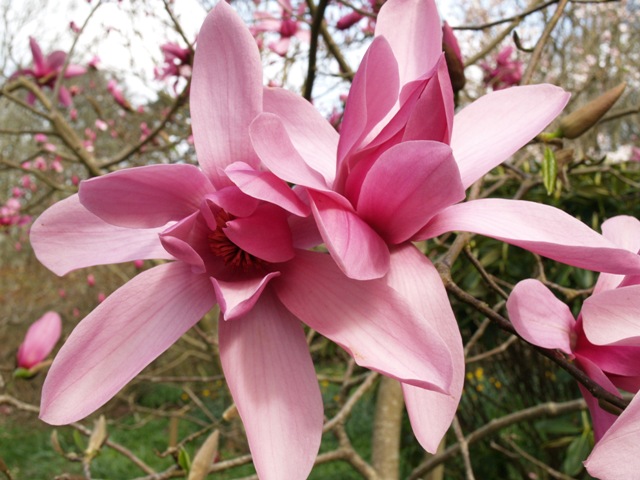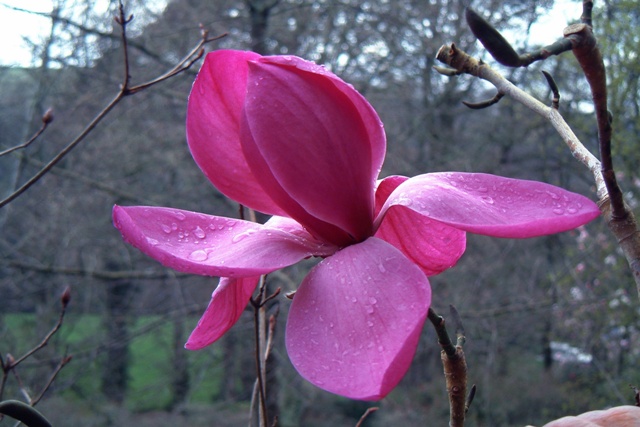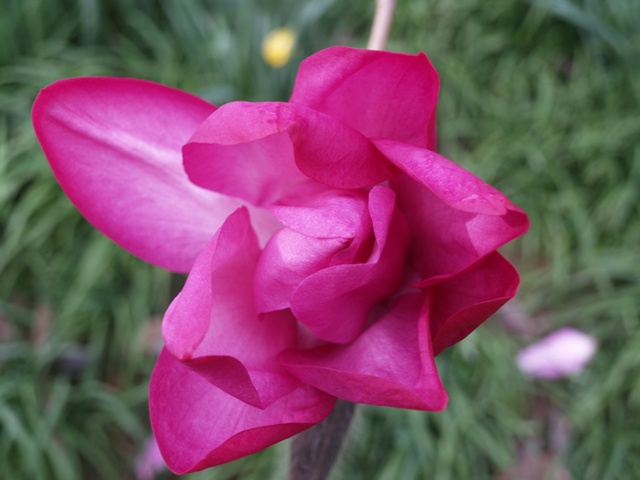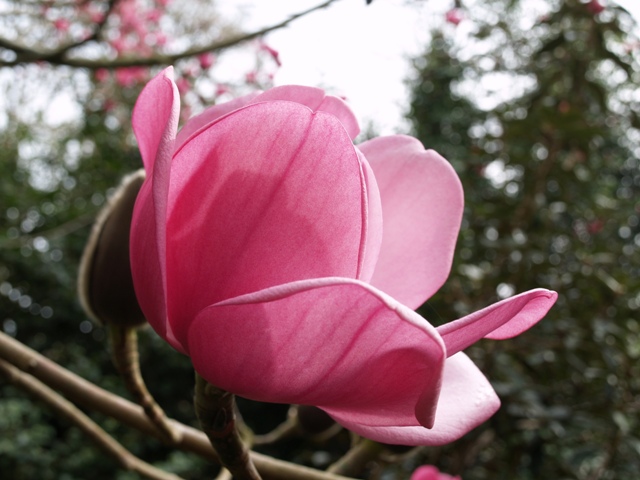Magnolias
Bred & Raised at Caerhays and Burncoose
‘Caerhays Surprise ‘
(M. campbellii x mollicomata sub M. liliiflora ‘Nigra’)
Bred by Philip Tregunna , Head Gardener, in 1959.
First flowered in 1967. AM and Cory Cup in 1973.
Read about how to make your own Magnolia hybrid on Burncoose Nurseries website.
As there only about 80 species of magnolias, the number of possible crosses between species is much more restricted.
In the UK climate not that many magnolias do actually set seed so the hybridiser is again restricted in his choice of subject. In addition evergreen magnolias will not cross with deciduous ones and pollen from magnolias which flower in the spring can hardly be used on summer flowering varieties (at least by amateurs).
All these problems mean that there are perhaps only 1200 – 1500 properly registered and recorded varieties of magnolia hybrid worldwide.
In our Magnolia history section we explained why pink is the genetically dominant colour in the majority of tree magnolias. This is even more true when breeding.
For every thousand magnolia seedlings which grow on to become flowering plants perhaps only one will be sufficiently different in terms of colour, habit or flowering time/period to enable it to be worthy of formal registration by the Royal Horticultural Society and the International Magnolia Society. The remainder may be very nice plants or even extremely lovely plants but they will not be sufficiently different to be worthy of a name and registration.
Naturally people who make deliberate magnolia crosses and try hard to produce something new and different are very much more likely to find success than the keen gardener who simply grows lots of random seedlings which he has collected. However genetics can throw up random surprises but very very seldom indeed.
What has happened is that scores, if not hundreds, of magnolias have been named by people who very much like them in their own gardens. We have Magnolia campbellii Lamellyn, Sidbury, Wakehurst, Lanhydroch – to mention but a few well known gardens. They are good, even great plants, but are they sufficiently different to be worthy of a separate name? Perhaps or perhaps not?
Then you get the experienced breeder who produces lots of seedlings (all different of course) from his deliberate crosses. Instead of waiting to see how they perform individually over several years and selecting the very best only for naming, the breeder gets carried away and names/registers far too many. We end up with lots of magnolias which are very similar indeed and the public get confused. They want to buy excellence but do not know how to find it.
If you look at the labels on the magnolia plants at Caerhays some will just say M. mollicomata x M. ‘Lanarth’. This means that the plant was a deliberate cross rather than a chance seedling. (If it was a chance seedling it would say x unknown for the ‘Pollen Parent’). Effectively this means here is a possibly quite decent Caerhays bred hybrid which sadly is not good enough for formal naming and registration.
Since we all accept that most magnolia seedlings take at least ten years to flower the process of hybridisation in magnolias is very slow indeed and, in a lifetime, there are few chances to improve on your earlier mistakes.
And that is not the end of the story either. If a plant does get named and registered it has to be exceptionally good if it is to achieve commercial success and be grown and propagated by nurseries.
Caerhays Bred and Raised Hybrids
In keeping with the strongly held beliefs outlined above Caerhays has named only half a dozen new magnolias in the last 50 years.
One of the problems of gardening in Cornwall is that to achieve success with a new hybrid you have to take it to the appropriate RHS Committee in London for exhibition. That is easier said than done with a large sprig of delicate magnolia flowers wrapped in lavatory paper to stop them opening prematurely and parked in the basin in a small overnight sleeper cabin on the train to London.
The other problem is that magnolias do not know when the RHS Committees and monthly shows at Vincent Square actually take place. Year after year the new hybrid flowers too early or too late to be presented to the Committee or it gets turned to a brown mush by hailstones or frost two days before the show.
On the rare occasions when a new magnolia hybrid is actually shown to the Committee they can decide to award it an Award of Merit (AM) – 60% majority of those voting or a First Class Certificate (FCC) – 75% majority of those voting. The flowers are judged on how they look at the time and not at all how they might have looked before the train and taxi ride to Vincent Square. If the Committee are even more impressed, they may recommend that the Magnolia goes for trialling at Wisley to see whether it is worthy of an Award of Garden Merit (AGM). This is the supreme RHS accolade which means the plant is considered suitable for growing in most gardens and is, or should be, available very widely. Very few magnolias have AGMs and none of the Caerhays hybrids have risen to such dizzy heights.
Specialist Nurserymen and some more enlightened garden centres will only stock excellent magnolias that will sell and are reasonably well known. In view of the timescales involved in breeding and then exhibiting magnolias you will again see why progress is very slow.
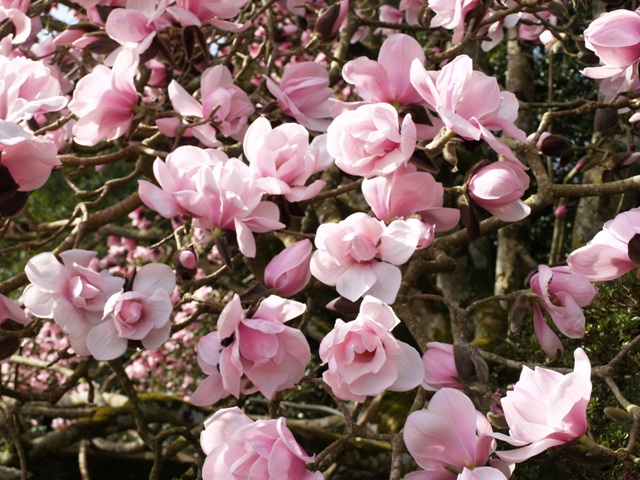
‘Caerhays Belle’
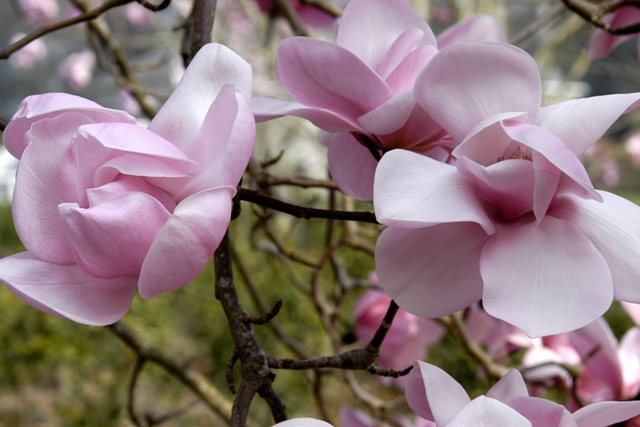
‘Kew’s Surprise’
‘J.C. Williams’
(M.sargentiana var robusta
x M. sprengeri ‘Diva’).
Bred by Head Gardener, Charles Michael, in 1951.
It took 14 years to flower.
M. campbellii ‘Kew’s Surprise’. A seedling of M.‘Charles Raffill’ (M. campbellii x M.campbellii var mollicomata) Raised at Caerhays. FCC and Cory Cup 1967. First flowered in 1967.
(M. sargentiana var robusta x M. sprengeri ‘Diva’) Registered with the International Magnolia Society in 1997. Measured 45ft tall with a girth of 5ft in 2001.FCC March 2002.
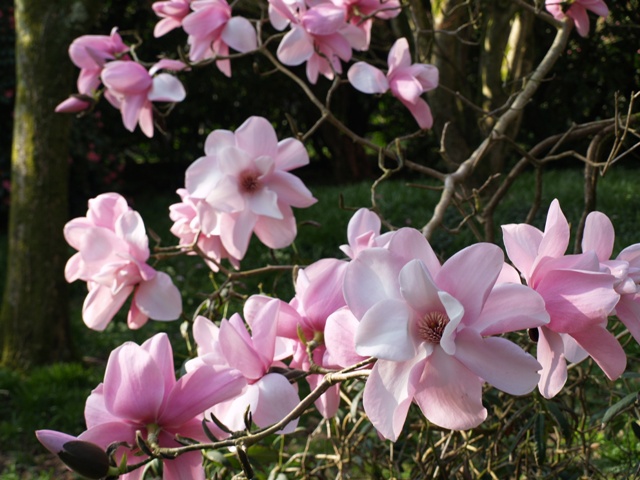
‘Delia Williams’
‘F.J. Williams’
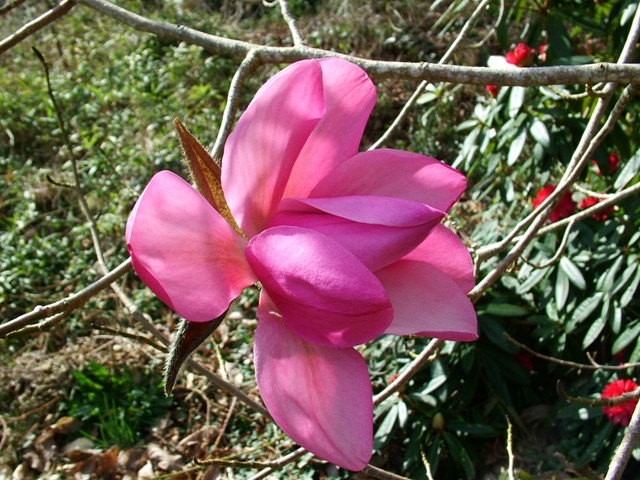
‘Diva’ ‘Burncoose’
‘Delia Williams’ (M. sargentiana var robusta x campbellii var mollicomata) First flowered in 1972 seven years after being planted out.Registered 2009.
‘F.J. Williams’ (M. sargentiana var robusta x M. mollicomata ‘Lanarth’) Planted in 1987, registered and named 2009.
M. sprengeri var ‘Diva’ ‘Burncoose’. A seedling of sprengeri ‘Diva’ raised by Arnold Dance, Head Gardener, at Burncoose. It first flowered in 1972 and was awarded an AM in 2000.
‘Philip Tregunna’
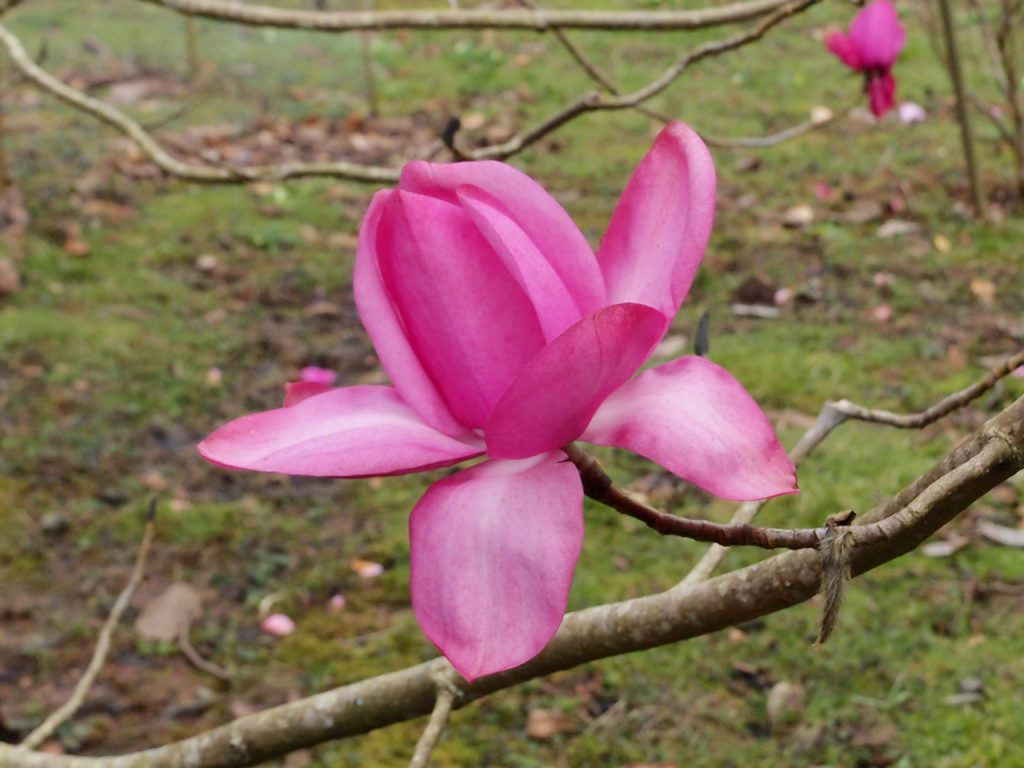
‘Magnolia ‘Caerhay’s Splendour’
‘Philip Tregunna’ (M. sargentiana var robusta x M. campbellii). First flowered in 1968. Awarded FCC in 1992. Named after Philip Tregunna, Head Gardener at Caerhays from 1956 to 1996.
‘Caerhays Splendour’ (M. sargentiana var. robusta x M. campbellii subsp. mollicomata ‘Lanarth’) x M. campbellii ‘Darjeeling. Bred by Head Gardener Jaimie Parsons in 2000. First flowered in 2011. Registered in 2014.

